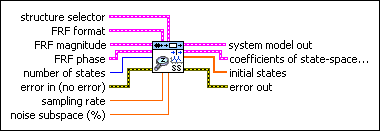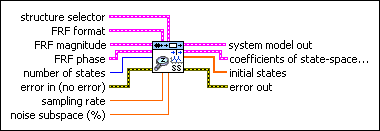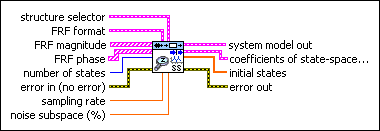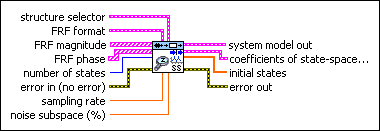Owning Palette: Frequency-Domain Model Estimation VIs
Installed With: System Identification Toolkit
Estimates the parameters of a discrete state-space (SS) model for an unknown system by using a frequency response function (FRF). Wire data to the FRF magnitude and FRF phase inputs to determine the polymorphic instance to use or manually select the instance.
You can obtain the FRF of a plant by using the SI Estimate FRF VI. You can wire the FRF magnitude and FRF phase outputs of the SI Estimate FRF VI to the FRF magnitude and FRF phase inputs of the SI Estimate State-Space Model from FRF VI.
Use the pull-down menu to select an instance of this VI.
 Place on the block diagram Place on the block diagram |  Find on the Functions palette Find on the Functions palette |
SI Estimate Discrete State-Space Model from FRF (SISO Arbitrary)

 | structure selector specifies whether this VI computes the D matrix and the initial states of the state-space model you want to estimate.
| ||||||||
 | FRF format specifies the format of the FRF magnitude and the FRF phase.
| ||||||||
 | FRF magnitude specifies the magnitude of the averaged frequency response and frequency scale.
| ||||||||
 | FRF phase specifies the phase of the averaged frequency response and frequency scale.
| ||||||||
 | number of states specifies the number of states of the system model. The value of number of states must be greater than 0. The default is 4. | ||||||||
 | error in describes error conditions that occur before this VI or function runs.
The default is no error. If an error occurred before this VI or function runs, the VI or function passes the error in value to error out. This VI or function runs normally only if no error occurred before this VI or function runs. If an error occurs while this VI or function runs, it runs normally and sets its own error status in error out. Use the Simple Error Handler or General Error Handler VIs to display the description of the error code. Use error in and error out to check errors and to specify execution order by wiring error out from one node to error in of the next node.
| ||||||||
 | sampling rate specifies the sampling frequency, in hertz, of the estimated discrete system model. The value of sampling rate must be greater than 0. The default value is twice the highest frequency of the FRF data. | ||||||||
 | noise subspace specifies the percentage of the noise subspace in the whole space, which is the combination of the signal subspace and the noise subspace. The default is 50. | ||||||||
 | system model out returns information about the model structure, nominal or estimated parameters, identification result, and so on. Use the Model Management VIs to retrieve the information system model out contains.
| ||||||||
 | coefficients of state-space model returns the coefficients of the state-space model.
| ||||||||
 | initial states returns the initial states of the state-space model. The length of initial states equals the number of states of the system model. | ||||||||
 | error out contains error information. If error in indicates that an error occurred before this VI or function ran, error out contains the same error information. Otherwise, it describes the error status that this VI or function produces.
Right-click the error out front panel indicator and select Explain Error from the shortcut menu for more information about the error.
|
SI Estimate Discrete State-Space Model from FRF (SISO Uniform)

 | structure selector specifies whether this VI computes the D matrix and the initial states of the state-space model you want to estimate.
| ||||||||
 | FRF format specifies the format of the FRF magnitude and the FRF phase.
| ||||||||
 | FRF magnitude specifies the magnitude of the averaged frequency response and frequency scale.
| ||||||||
 | FRF phase specifies the phase of the averaged frequency response and frequency scale.
| ||||||||
 | number of states specifies the number of states of the system model. The value of number of states must be greater than 0. The default is 4. | ||||||||
 | error in describes error conditions that occur before this VI or function runs.
The default is no error. If an error occurred before this VI or function runs, the VI or function passes the error in value to error out. This VI or function runs normally only if no error occurred before this VI or function runs. If an error occurs while this VI or function runs, it runs normally and sets its own error status in error out. Use the Simple Error Handler or General Error Handler VIs to display the description of the error code. Use error in and error out to check errors and to specify execution order by wiring error out from one node to error in of the next node.
| ||||||||
 | sampling rate specifies the sampling frequency, in hertz, of the estimated discrete system model. The value of sampling rate must be greater than 0. The default value is twice the highest frequency of the FRF data. | ||||||||
 | noise subspace specifies the percentage of the noise subspace in the whole space, which is the combination of the signal subspace and the noise subspace. The default is 50. | ||||||||
 | system model out returns information about the model structure, nominal or estimated parameters, identification result, and so on. Use the Model Management VIs to retrieve the information system model out contains.
| ||||||||
 | coefficients of state-space model returns the coefficients of the state-space model.
| ||||||||
 | initial states returns the initial states of the state-space model. The length of initial states equals the number of states of the system model. | ||||||||
 | error out contains error information. If error in indicates that an error occurred before this VI or function ran, error out contains the same error information. Otherwise, it describes the error status that this VI or function produces.
Right-click the error out front panel indicator and select Explain Error from the shortcut menu for more information about the error.
|
SI Estimate Discrete State-Space Model from FRF (MIMO Arbitrary)

 | structure selector specifies whether this VI computes the D matrix and the initial states of the state-space model you want to estimate.
| ||||||||
 | FRF format specifies the format of the FRF magnitude and the FRF phase.
| ||||||||
 | FRF magnitude specifies the magnitude of the averaged frequency response and frequency scale.
| ||||||||
 | FRF phase specifies the phase of the averaged frequency response and frequency scale.
| ||||||||
 | number of states specifies the number of states of the system model. The value of number of states must be greater than 0. The default is 4. | ||||||||
 | error in describes error conditions that occur before this VI or function runs.
The default is no error. If an error occurred before this VI or function runs, the VI or function passes the error in value to error out. This VI or function runs normally only if no error occurred before this VI or function runs. If an error occurs while this VI or function runs, it runs normally and sets its own error status in error out. Use the Simple Error Handler or General Error Handler VIs to display the description of the error code. Use error in and error out to check errors and to specify execution order by wiring error out from one node to error in of the next node.
| ||||||||
 | sampling rate specifies the sampling frequency, in hertz, of the estimated discrete system model. The value of sampling rate must be greater than 0. The default value is twice the highest frequency of the FRF data. | ||||||||
 | noise subspace specifies the percentage of the noise subspace in the whole space, which is the combination of the signal subspace and the noise subspace. The default is 50. | ||||||||
 | system model out returns information about the model structure, nominal or estimated parameters, identification result, and so on. Use the Model Management VIs to retrieve the information system model out contains.
| ||||||||
 | coefficients of state-space model returns the coefficients of the state-space model.
| ||||||||
 | initial states returns the initial states of the state-space model. The length of initial states equals the number of states of the system model. | ||||||||
 | error out contains error information. If error in indicates that an error occurred before this VI or function ran, error out contains the same error information. Otherwise, it describes the error status that this VI or function produces.
Right-click the error out front panel indicator and select Explain Error from the shortcut menu for more information about the error.
|
SI Estimate Discrete State-Space Model from FRF (MIMO Uniform)

 | structure selector specifies whether this VI computes the D matrix and the initial states of the state-space model you want to estimate.
| ||||||||
 | FRF format specifies the format of the FRF magnitude and the FRF phase.
| ||||||||
 | FRF magnitude specifies the magnitude of the averaged frequency response and frequency scale.
| ||||||||
 | FRF phase specifies the phase of the averaged frequency response and frequency scale.
| ||||||||
 | number of states specifies the number of states of the system model. The value of number of states must be greater than 0. The default is 4. | ||||||||
 | error in describes error conditions that occur before this VI or function runs.
The default is no error. If an error occurred before this VI or function runs, the VI or function passes the error in value to error out. This VI or function runs normally only if no error occurred before this VI or function runs. If an error occurs while this VI or function runs, it runs normally and sets its own error status in error out. Use the Simple Error Handler or General Error Handler VIs to display the description of the error code. Use error in and error out to check errors and to specify execution order by wiring error out from one node to error in of the next node.
| ||||||||
 | sampling rate specifies the sampling frequency, in hertz, of the estimated discrete system model. The value of sampling rate must be greater than 0. The default value is twice the highest frequency of the FRF data. | ||||||||
 | noise subspace specifies the percentage of the noise subspace in the whole space, which is the combination of the signal subspace and the noise subspace. The default is 50. | ||||||||
 | system model out returns information about the model structure, nominal or estimated parameters, identification result, and so on. Use the Model Management VIs to retrieve the information system model out contains.
| ||||||||
 | coefficients of state-space model returns the coefficients of the state-space model.
| ||||||||
 | initial states returns the initial states of the state-space model. The length of initial states equals the number of states of the system model. | ||||||||
 | error out contains error information. If error in indicates that an error occurred before this VI or function ran, error out contains the same error information. Otherwise, it describes the error status that this VI or function produces.
Right-click the error out front panel indicator and select Explain Error from the shortcut menu for more information about the error.
|
SI Estimate State-Space Model from FRF Details
If the frequency-domain data you wire to the FRF magnitude and FRF phase inputs is spaced uniformly, use the Uniform polymorphic instance of this VI. In this situation, you must specify the starting frequency f0 and the frequency increment df. If this data is spaced arbitrarily, use the Arbitrary polymorphic instance of this VI. | Note You also can use the Arbitrary polymorphic instance if the frequency-domain data you wire to the FRF magnitude and FRF phase inputs is spaced uniformly. |
Examples
Refer to the following VIs for examples of using the SI Estimate State-Space Model from FRF VI:
- Estimate State-Space Model from FRFs VI: labview\examples\System Identification\Getting Started\Frequency Domain Identification.llb
- Flexible Arm (Frequency Domain) VI: labview\examples\System Identification\Industry Applications\Mechanical Systems.llb







